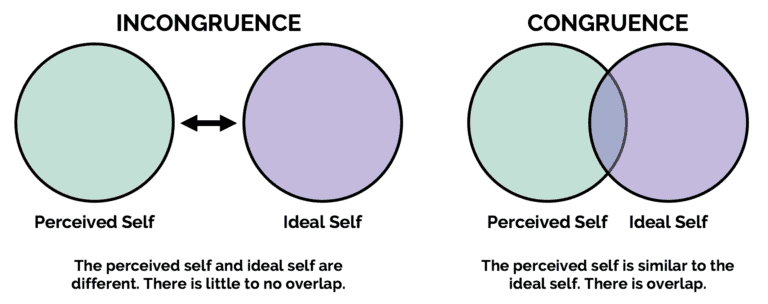Tokyo Mental Health is here to support you and provide you with the help you need.
What is person-centered therapy?
Person-centered or client-centered therapy was founded by Carl Rogers in the 1950s. Rogers believed that each individual can grow and change to fulfill their potential – he called this the self-actualizing tendency. However, there are many factors that prevent us from growing and fulfilling our potential. These factors include: our social environment, not being open to our experiences, being unable to trust oneself and others, and not having acceptance and compassion for oneself.
As no one else can know how we perceive, we are the best experts on ourselves.
Rogers (1961) Tweet
According to Rogers, in order to move towards growth and self-actualization there are three conditions that need to be fulfilled. These conditions can be provided by the therapist in the therapy room:
Congruence – the therapist is genuine and authentic
Empathy – the therapist strives to understand the client’s internal frame of reference (thoughts and feelings)
Unconditional Positive Regard – the therapist provides a non-judgmental environment that allows the client to feel valued and accepted
In person-centered therapy, the client comes to the therapy room “incongruent”. This means that their self-image does not meet the image of their ideal self. The therapist aims to help the client move towards congruence by providing the three conditions above – this is what we call growth or self-actualization. It is vital that the therapist models congruence for the client and allows the client to experience the therapist as genuine and authentic. Combined with the therapist’s empathy and unconditional positive regard, the client can learn to accept their current self-image and integrate that into their ideal self-image, or they can choose to make changes and adjust their self-image to match their ideal self.
We think we listen, but very rarely do we listen with real understanding, true empathy. Yet listening, of this very special kind, is one of the most potent forces for change that I know.
Rogers (1975) Tweet

Person-Centered Therapy aims to:
- Empower the client
- Assist the client towards acceptance and compassion
- Cultivate self-awareness
- Facilitate personal growth
- Increase self-esteem/self-worth
- Decrease or Eliminate feelings of distress
- Improve communication about one’s feelings
- Improve relationships
The curious paradox is that when I accept myself just as I am, then I can change.
Rogers (1961) Tweet
Is Person-Centered Therapy right for me?
Due to the nature of person-centered therapy, it is best suited for those who wish to have a greater understanding of themselves. Research suggests it can be particularly useful for people struggling with interpersonal/relational problems, trauma, anxiety and mild depression. However, approaches such as CBT, can be more appropriate for those dealing with more medicalised mental health problems, such as more severe depressive disorder, panic disorder or generalised anxiety disorder. Also, compared to other kinds of approaches, person-centered therapy can require the client to do a lot of the work in the session as the therapist takes a non-directive approach. Having said that, it is important to recognise that individual differences will affect which approach ‘works’ best so please feel free to contact us at Tokyo Mental Health for advice on which approach might suit your needs.
It is the client who knows what hurts, what directions to go, what problems are crucial, what experiences have been deeply buried.
Rogers (1975) Tweet
What does Person-Centered Therapy look like in practice?
Usually, clients will come weekly or bi-weekly to begin with, based on their individual needs. This can be discussed with the therapist after the first session and they will be able to help you to decide the frequency of your sessions based on your concerns. After a few sessions (6 or more), if it is appropriate to your needs you can also consider monthly sessions.
Typically, the therapist will open with a general question that allows you to choose what you’d like to discuss. For the first session, it is usually an overview of the general problems that you are experiencing. From session two onwards, it will be a continued exploration of your concerns but each session might focus on something different. After a few sessions (4-6), the client and therapist can generally get a sense of the bigger picture and this is where exploring potential changes to behavior or going more in-depth about thoughts and feelings can occur. For those who need short-term therapy, generally 12 sessions is an appropriate amount. However, the person-centered approach is very flexible and well-suited for long-term therapy. For this reason, there is no recommended number of sessions that clients should take and it will usually be decided between the client and therapist when it is appropriate to terminate therapy.
People are just as wonderful as sunsets if you let them be. When I look at a sunset, I don't find myself saying, ‘Soften the orange a bit on the right hand corner.’ I don't try to control a sunset. I watch with awe as it unfolds.
Rogers (1995) Tweet
References
- Rogers, C. R. (1957). The necessary and sufficient conditions of therapeutic personality change. Journal of consulting psychology, 21(2), 95.
- Rogers, C. (1959). A theory of therapy, personality and interpersonal relationships as developed in the client-centered framework. In (ed.)
- Rogers, C. (1961). Toward a theory of creativity. On Becoming a person. Boston: Houghton Mifflin.-1961.
- Rogers, C. R. (1975). Empathic: An unappreciated way of being. The counseling psychologist, 5(2), 2-10.
- Rogers, C. R. (1995). A way of being. Houghton Mifflin Harcourt.
- Elliott, R. (2016). Research on person-centred/experiential psychotherapy and counselling: summary of the main findings.